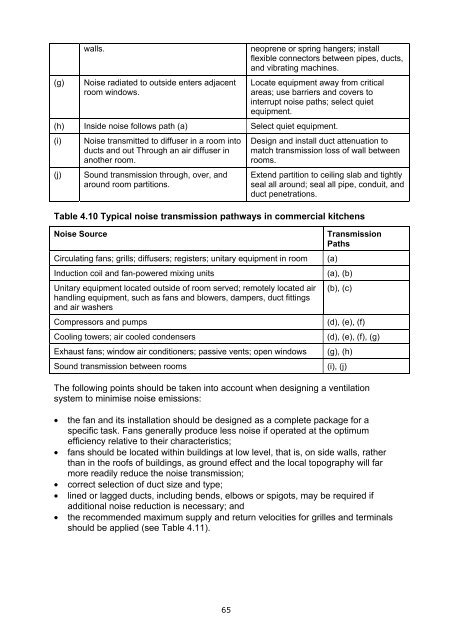Guidance on the Control of Odour and Noise from ... - Defra
Guidance on the Control of Odour and Noise from ... - Defra
Guidance on the Control of Odour and Noise from ... - Defra
You also want an ePaper? Increase the reach of your titles
YUMPU automatically turns print PDFs into web optimized ePapers that Google loves.
walls.<br />
(g) <strong>Noise</strong> radiated to outside enters adjacent<br />
room windows.<br />
65<br />
neoprene or spring hangers; install<br />
flexible c<strong>on</strong>nectors between pipes, ducts,<br />
<strong>and</strong> vibrating machines.<br />
Locate equipment away <strong>from</strong> critical<br />
areas; use barriers <strong>and</strong> covers to<br />
interrupt noise paths; select quiet<br />
equipment.<br />
(h) Inside noise follows path (a) Select quiet equipment.<br />
(i) <strong>Noise</strong> transmitted to diffuser in a room into<br />
ducts <strong>and</strong> out Through an air diffuser in<br />
ano<strong>the</strong>r room.<br />
(j) Sound transmissi<strong>on</strong> through, over, <strong>and</strong><br />
around room partiti<strong>on</strong>s.<br />
Design <strong>and</strong> install duct attenuati<strong>on</strong> to<br />
match transmissi<strong>on</strong> loss <strong>of</strong> wall between<br />
rooms.<br />
Extend partiti<strong>on</strong> to ceiling slab <strong>and</strong> tightly<br />
seal all around; seal all pipe, c<strong>on</strong>duit, <strong>and</strong><br />
duct penetrati<strong>on</strong>s.<br />
Table 4.10 Typical noise transmissi<strong>on</strong> pathways in commercial kitchens<br />
<strong>Noise</strong> Source Transmissi<strong>on</strong><br />
Paths<br />
Circulating fans; grills; diffusers; registers; unitary equipment in room (a)<br />
Inducti<strong>on</strong> coil <strong>and</strong> fan-powered mixing units (a), (b)<br />
Unitary equipment located outside <strong>of</strong> room served; remotely located air<br />
h<strong>and</strong>ling equipment, such as fans <strong>and</strong> blowers, dampers, duct fittings<br />
<strong>and</strong> air washers<br />
(b), (c)<br />
Compressors <strong>and</strong> pumps (d), (e), (f)<br />
Cooling towers; air cooled c<strong>on</strong>densers (d), (e), (f), (g)<br />
Exhaust fans; window air c<strong>on</strong>diti<strong>on</strong>ers; passive vents; open windows (g), (h)<br />
Sound transmissi<strong>on</strong> between rooms (i), (j)<br />
The following points should be taken into account when designing a ventilati<strong>on</strong><br />
system to minimise noise emissi<strong>on</strong>s:<br />
• <strong>the</strong> fan <strong>and</strong> its installati<strong>on</strong> should be designed as a complete package for a<br />
specific task. Fans generally produce less noise if operated at <strong>the</strong> optimum<br />
efficiency relative to <strong>the</strong>ir characteristics;<br />
• fans should be located within buildings at low level, that is, <strong>on</strong> side walls, ra<strong>the</strong>r<br />
than in <strong>the</strong> ro<strong>of</strong>s <strong>of</strong> buildings, as ground effect <strong>and</strong> <strong>the</strong> local topography will far<br />
more readily reduce <strong>the</strong> noise transmissi<strong>on</strong>;<br />
• correct selecti<strong>on</strong> <strong>of</strong> duct size <strong>and</strong> type;<br />
• lined or lagged ducts, including bends, elbows or spigots, may be required if<br />
additi<strong>on</strong>al noise reducti<strong>on</strong> is necessary; <strong>and</strong><br />
• <strong>the</strong> recommended maximum supply <strong>and</strong> return velocities for grilles <strong>and</strong> terminals<br />
should be applied (see Table 4.11).
















